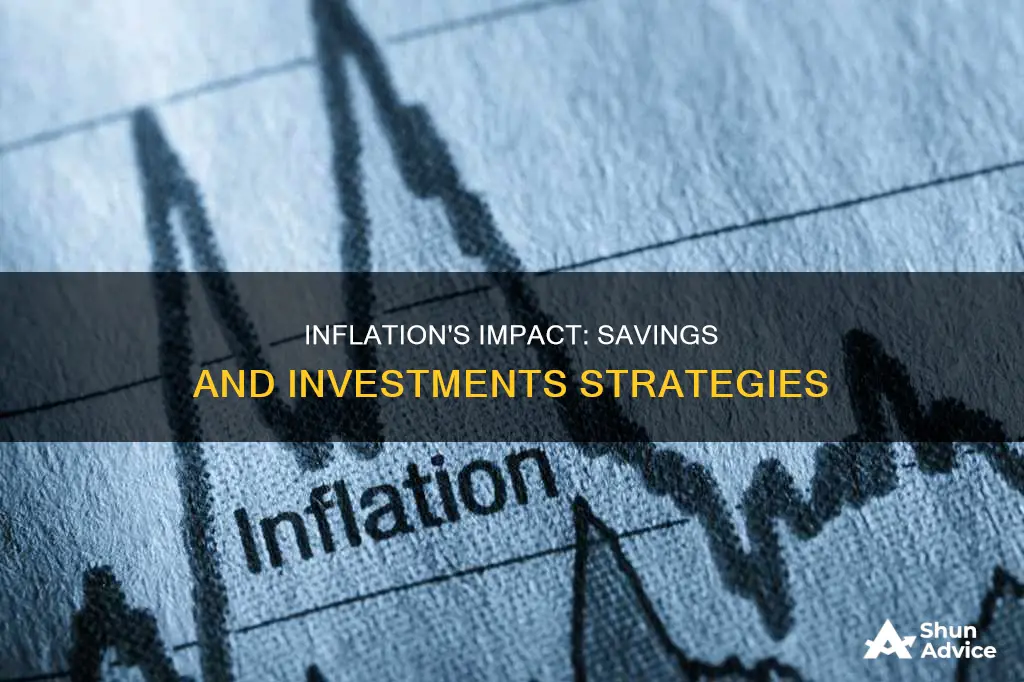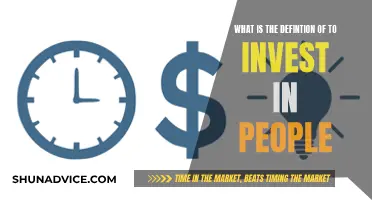
Inflation is a complex economic phenomenon that affects the purchasing power of consumers, causing a general rise in the prices of goods and services over time. It has a significant impact on consumer savings and investments, eroding the value of money saved and reducing the buying power of individuals. This is especially detrimental for those with savings accounts, as the interest earned often fails to keep up with the rate of inflation, resulting in a loss of purchasing power. Inflation also influences investment returns, with nominal interest rates needing to outpace inflation for investors to earn real returns. This is particularly challenging for investments with lower interest rates, such as cash and cash equivalents. Understanding the dynamics of inflation and its effects on different asset classes is crucial for making informed financial decisions and preserving the value of savings.
| Characteristics | Values |
|---|---|
| Definition of inflation | Inflation is the rise in prices of goods and services over time. |
| Impact on purchasing power | Inflation erodes the purchasing power of money. |
| Impact on savings | Inflation can shrink savings, even in accounts with interest rates. |
| Impact on investments | Inflation can negatively impact investment returns, especially for cash and cash equivalents. |
| Impact on interest rates | Inflation and interest rates tend to move in the same direction. |
| Impact on debt | Inflation lowers the cost of servicing debt for those with fixed-rate mortgages or loans. |
| Impact on the economy | Inflation can lead to faster economic growth and lower unemployment in the short term, but cause painful recessions in the long term. |
| Impact on specific assets | Inflation tends to hurt bonds and growth stocks while benefiting real estate, energy, and value stocks. |
| Strategies to protect against inflation | Diversification across asset classes, investing in inflation-protected securities, investing in stocks, buying inflation hedges (e.g., gold, real estate), owning rental real estate. |
What You'll Learn

Inflation erodes purchasing power
Inflation Eroding Purchasing Power
Inflation is the rise in prices of goods and services over time. It is a complex economic phenomenon that occurs when the purchasing power of money declines, and it has a significant impact on consumers, businesses, investors, and the overall economy. Inflation erodes purchasing power, and this is considered its primary and most pervasive effect.
How Inflation Impacts Purchasing Power
When prices rise, consumers' purchasing power decreases because a fixed amount of money will buy less. Even if a consumer has more money in their savings, it won't go as far, and they will be able to afford fewer goods and services. This loss of purchasing power happens regardless of the inflation rate, but the higher the inflation rate, the faster purchasing power declines.
For example, if you have $100 in a savings account earning 1% interest, you will have $101 at the end of the year. However, if the inflation rate is 2%, you would need $102 to maintain your original purchasing power. So, while you gained a dollar, your buying power has decreased.
The Impact of Inflation on Savings and Investments
Inflation can shrink your savings even if they are in an account with an interest rate. This is because the interest rate must be higher than the inflation rate to maintain purchasing power. If the interest rate is lower, your savings will not keep up with rising prices, and your money will buy less over time.
Inflation also affects investments. Investments with lower interest rates, like cash and cash equivalents, are hit hard by inflation because they cannot generate enough interest to compete with the inflation rate. Inflation can also significantly reduce real returns on fixed-income investments like bonds and certificates of deposit.
Protecting Your Finances from Inflation
While inflation is unpredictable and can affect even the safest investments, there are ways to protect your finances:
- Invest in stocks, commodities, or real estate, which tend to do well during inflation.
- Buy inflation-protected securities like Treasury Inflation-Protected Securities (TIPS) or government bonds, which are adjusted based on inflation.
- Diversify your investments across asset classes to insulate your finances from market crashes.
- Look for accounts or investments that "beat inflation," meaning the interest or profit is higher than the inflation rate.
The Quest for Consistent $2000 Monthly: Exploring Reliable Investment Options
You may want to see also

Inflation impacts lower-income consumers
Lower-income earners also tend to spend a larger proportion of their weekly or monthly household budgets on food and energy. These commodities are hard to substitute or go without when prices spike.
Additionally, those with lower incomes are less likely to own assets like real estate, which has traditionally served as an inflation hedge.
Recipients of Social Security benefits and other federal transfer payments do receive inflation protection in the form of annual cost-of-living adjustments (COLA) that are based on the Consumer Price Index for Urban Wage Earners and Clerical Workers (CPI-W). However, this may not be enough to sustain the same standard of living they are used to when prices increase to certain levels.
The Wealthy Retiree's Investment Playbook: Strategies for Preserving and Growing Your Nest Egg
You may want to see also

Inflation lowers debt service costs
Inflation can have a significant impact on debt service costs, and this effect is twofold. On the one hand, inflation reduces the real value of debt. On the other hand, it increases future borrowing costs.
Firstly, inflation reduces the real value of a borrower's debt burden. This is because, as inflation increases, prices rise, and consequently, the value of money decreases. As a result, the purchasing power of a fixed amount of money declines. This means that, in real terms, the value of the borrower's debt decreases. For example, if a borrower owes a lender $1000, and there is an unexpected inflation rate of 10%, the value of that debt in real terms is now only $900. This transfer of wealth from lenders to borrowers makes it easier for borrowers to pay back their debts.
Secondly, inflation is likely to raise future borrowing costs. This is because investors will expect higher inflation and demand higher nominal yields on debt to compensate for the expected loss of purchasing power and the associated uncertainty. If the increase in nominal yields exceeds the increase in inflation, the ex-post real rate of interest will go up, and borrowers will have to repay more to lenders in terms of purchasing power.
For example, consider a one-year bond with a $1000 face value. The investor purchases the bond for $1000 and will not be paid back until the one-year period has elapsed. Over the next 12 months, the investor would receive interest payments (also called coupon payments) based on a 5% nominal interest rate. Factoring in a 3% inflation rate, the investor’s real rate of return on this bond is 2% rather than 5%. This means the real value of the returned principal investment is just $970.
In summary, while inflation can reduce the real value of debt in the short term, it is likely to increase the cost of servicing that debt in the long term.
Cheap Property Investment: Uncovering Hidden Gems
You may want to see also

Inflation reduces savings value
Secondly, inflation can negatively impact fixed-income investments such as bonds, treasuries, and certificates of deposit (CDs). These investments provide a stable income stream with regular interest payments. However, since the income stream typically remains constant until maturity, the purchasing power of the interest payments declines as inflation rises. As a result, the real returns on these investments are reduced, and investors may lose money in real terms.
Thirdly, inflation can affect savings in retirement plans. During an individual's working years, earnings ideally increase at a similar rate as inflation to maintain purchasing power. However, during retirement, when individuals live off their savings, inflation diminishes their buying power over time. Therefore, it is crucial to monitor savings against inflation to ensure that retirees have sufficient funds to sustain their desired lifestyle.
Lastly, inflation can impact savings by influencing interest rates. When inflation is high, banks tend to offer higher interest rates on savings accounts. However, if the inflation rate exceeds the interest rate, the savings will lose value. Thus, it is essential to consider the impact of inflation when making financial decisions regarding savings and investments.
Navigating the Global Markets: Strategies for Investing Amidst Dollar Tightening
You may want to see also

Inflation affects fixed-income investments
Fixed-income investments are investments in the debt of a government or a company. They deliver regular payments, sometimes called coupons, to the holders of the debt until the date they reach maturity. The initial investment is then returned. Examples include corporate bonds, federal, state, and municipal bonds, and bank certificates of deposit (CDs).
Inflation can significantly reduce real returns on fixed-income investments. Typically, investors buy fixed-income securities because they want a stable income stream in the form of interest payments. However, since the income stream remains the same on most fixed-income securities until maturity, the purchasing power of the interest payments declines as inflation rises. As a result, bond prices tend to fall when inflation is increasing.
Here's an example: consider a one-year bond with a $1,000 face value. The investor purchases the bond for $1,000 and will not be paid back until the one-year period has elapsed. Over the next 12 months, the investor would receive interest payments (also called coupon payments) based on a 5% nominal interest rate. Factoring in a 3% inflation rate, the investor’s real rate of return on this bond is 2% rather than 5%. This means the real value of the returned principal investment is just $970.
Longer-term bonds are more affected by inflation because they’re further from maturity than shorter-term bonds. The longer the term of a bond, the greater the risk that inflation will hurt the investor's real return.
A high inflation rate will reduce your real return. Inflation can have a negative effect on fixed-income assets when it leads to higher interest rates. Central banks like the U.S. Federal Reserve typically set inflation targets, and when inflation exceeds the desired threshold, they raise interest rates to bring it under control. Since the interest payments from existing fixed-income assets become less competitive relative to newer higher-rate fixed-income instruments, the prices of existing fixed-income assets in the bond market will fall.
Inflation typically occurs during periods of economic strength, which forces increases in the costs of wages, merchandise, and commodities. During times of inflation, it’s best to have a passive approach to investments. Diversifying your investment portfolio by investing your funds in a money market or market index account is the best strategy.
TBN Network's Retirement Fund Options: A Secure Investment Path?
You may want to see also
Frequently asked questions
Inflation erodes the purchasing power of your savings. If the interest rate on your savings is lower than the inflation rate, you are losing money as your savings won't be able to buy as much as they used to.
You can invest your savings in assets that are expected to perform well during inflationary times, such as commodities (e.g. gold, silver, oil), stocks, and inflation-indexed bonds.
Inflation can hurt some investments, such as bonds and growth stocks. However, it can boost the performance of other investments, such as real estate, energy, and value stocks.







